- TABLE OF CONTENTS
- DESIGN
- Introduction to Design
- Active Family
- Empty Nesters
- Young Professionals
- Questionnaire
- Principles of Design
- Design Concepts
- Working With Professionals
- Drainage
- Soil
- Climate/Weather
- Safety
- Landscape & Irrigation Plans
- Landscape Design
- Installing the Garden
- Hydrozoning
- Public and Demonstration Gardens
- Xeriscape
- Garden Care
- Composting
- Lawn
- Maintaining Your Garden
- Plant Water Needs
- Mulch
- Pest Management
- Growing a Healthy Garden
- Reading a Pesticide Label
- Pruning Landscape Plants
- Planting Instructions
- IRRIGATION
- Irrigation 101
- Types of Irrigation Systems
- Upgrading Existing System
- Choosing an Irrigation Control System
- Irrigation, Maintenance and Troubleshooting
- Eliminating Run-off and Overspray
- Acknowledgments
Landscape & Irrigation Plans
Draw the outlines of your property on graph paper. Locate the house, pool, trees, and other permanent structures on the plan. Overlay the base map with sheets of tracing paper and sketch in your designs. You don’t need to be an artist, just draw to scale. Be sure to use realistic dimensions for the activity desired in a given area. Generally, scales use the following reference points: 1/8 inch equals 1 foot. However, if your graph paper is divided into 1/4 inch squares, then use 1/4 inch equals 1 foot. An architectural scale is relatively inexpensive and can be purchased at an office supply or art store. It makes drawing to scale much easier. Consider the following when planning the layout of your garden:
| • | Permanent structures, such as decorative walls, retaining walls, fences, patios, gazebos, arbors, and trellises may require a permit for construction. Check with your building department or Home Owners Association for codes and restrictions |
| • | Pools and hot tubs require safety fencing. Check with your City’s building department for codes and restrictions. |
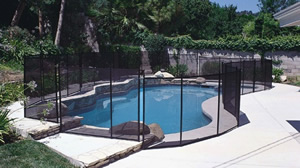 |
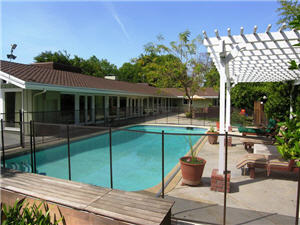 |
| • | Consider how you want to move through the yard and lay out sidewalks and paths accordingly. |
| • | Determine what areas of the house would benefit from having tree shade, e.g for a window. Trees should be placed far enough away from the house so the roots don’t cause future damage as they mature. A good rule of thumb is to plant a tree half the width of its mature canopy away from the house. |
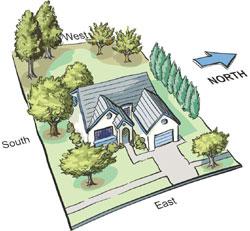
| • | Children’s play areas should be in clear view of a commonly used window. |
| • | The outdoor grill and dining area should be close to the kitchen. Do not place the grill on a flammable surface, such as a wood deck or under an overhang or patio cover. |
| • | Provide adequate dimensions for each proposed planting area. |
A cut-flower garden, vegetable garden, and/or compost bin should be screened or hidden from view, yet kept within easy access of the kitchen. Screening can be accomplished in several different ways:
Screening
Screening can be accomplished in several different ways:
| 1. | A row of trees can create definition and add seasonal color throughout the year. |
| 2. | Low shrubs and fences direct the eye, create outdoor rooms, and restrict foot traffic. |

Low hedges
| 3. | Tall hedges work well as exterior borders for outdoor rooms where you desire complete privacy or to block an unattractive view. |
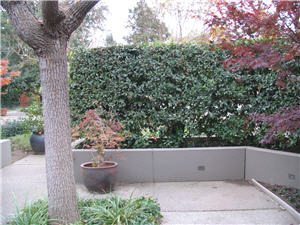
Tall hedges
| 4. | Arbors are especially good for screening off a vegetable or cutting garden, as well as providing pleasant, shady areas. |
| 5. | Existing walls, such as the garage, are a good choice for high screening. |
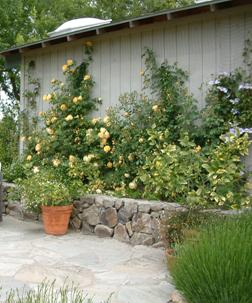
A decorative living screen for a plain wall.
| 6. | Changes in ground level using steps, terraces, or stairs are also a good screening technique. |
| 7. | An Espalier of fruit trees or evergreen shrubs makes a nice wall effect for garden rooms or screening areas. |
If you are having trouble drawing what your prospective garden plan might look like, mock up a fake version of the real thing. Tall stakes can stand in for trees or elements such as an arbor. Large pieces of cardboard can indicate paving or decks. Strings or garden hoses can outline paths and garden rooms. Leave the stakes, cardboard, and hoses in place for a few days to see how it influences traffic patterns, views, privacy, and access. Make changes as necessary.